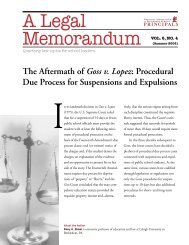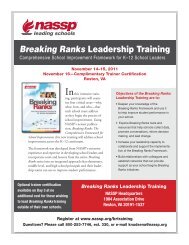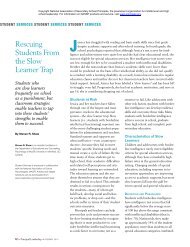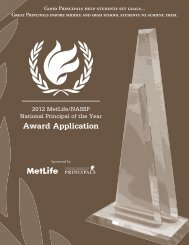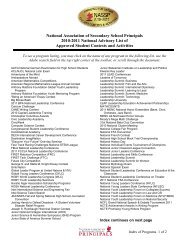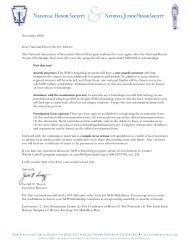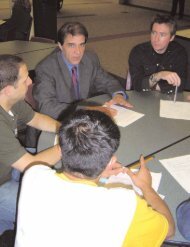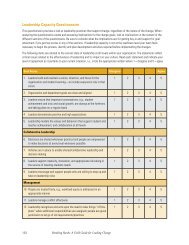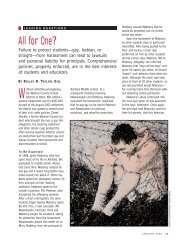Building Instructional Leadership - National Association of ...
Building Instructional Leadership - National Association of ...
Building Instructional Leadership - National Association of ...
You also want an ePaper? Increase the reach of your titles
YUMPU automatically turns print PDFs into web optimized ePapers that Google loves.
September 2007underscore the difficulty school leaders face in fulfillingthis demand:• Nearly 40% <strong>of</strong> public school principals—34,700individuals—headed schools that did not meet alldistrict and state performance standards• Half <strong>of</strong> those principals were required to write ormodify a school- or program-improvement planSeptember 2007• A third were placed on an evaluation cycle that requiredimprovementSeptember 2007• In the most severe cases, 5.6% <strong>of</strong> the schools wereSeptemberforced to replace2007the principal or undergo reconstitutionor takeover.In this climate, it is essential to define instructionalleadership and explore the leadership practices that makea difference in being an effective school leader.Defining <strong>Instructional</strong> <strong>Leadership</strong>A research analysis by Leithwood, Louis, Anderson, andWahlstrom (2004) confirmed that “leadership is secondonly to classroom instruction among all school-relatedfactors that contribute to what students learn at school”(p. 3). Moreover, principals’ effects on student performancetend to be largest “where and when they are neededmost… Indeed, there are virtually no documentedinstances <strong>of</strong> troubled schools being turned around withoutintervention by a powerful leader” (p. 3).What Works: Advice From the FieldRecommendations culled from interviews with teachers at aPortland, OR, middle school about what leadership practicesthey would like to see in principals:• Be visible and available to teachers. Merely saying “I havean open door policy” is not enough; you need to have a“drop-in policy” where you invite people to visit.• Ask teachers what you should look for during classroomvisits so as to provide meaningful feedback.• Set the standard for continuous learning by assigningbook readings and having discussion groups that are connectedwith specific expectations and goals.• Ensure that teachers have flexibility in using their planningtime most productively. Sometimes planning timesare structured and dictated by the principal or the topic <strong>of</strong>discussion is not directly related to teachers’ needs.• Provide more opportunities for staff to meet with facultyin other schools, to promote a coordinated effort districtwideand help them learn from one another.There are many forms <strong>of</strong> leadership, including September sitebased,collaborative, visionary, and distributive. How-2007ever, two models—instructional and transformational—September 2007have attracted the most attention. In simple terms,instructional leadership focuses on school September goals, climate, 2007and teaching; transformational leadership is broader andincludes school redesign and capacity building.The effective schools movement <strong>of</strong> the late 1970s andearly ’80s is credited with giving birth to the concept <strong>of</strong>instructional leadership. Principals <strong>of</strong> poor, urban schoolswere characterized as heroic leaders who tried to amelioratethe social and economic challenges that stood in theway <strong>of</strong> educational success. Over time, “the term ‘instructionalleadership’ has gradually become less the designation<strong>of</strong> a sharply defined set <strong>of</strong> leadership practices andmore a slogan chiding administrators to focus their effortson the ‘core technology’ <strong>of</strong> their schools and districts—teaching and learning” (Leithwood, 2005, p. 8).Hallinger (2003) detailed the characteristics <strong>of</strong> instructionalleadership in an analysis <strong>of</strong> studies conductedfrom 1980–2000. He described three main categories <strong>of</strong>practice:1. Define the school’s mission—oversee the development<strong>of</strong> specific school goals and ensure they are communicatedclearly to all members <strong>of</strong> the school community.2. Manage the instructional program—supervise andevaluate instruction, coordinate curriculum, andmonitor student progress.3. Promote a positive school learning climate—theheart <strong>of</strong> the model. Provide incentives for teachersand learning, promote pr<strong>of</strong>essional development, andprotect instructional time.Transformational leadership—along with other formssuch as shared or distributed leadership—emerged because<strong>of</strong> “a broader dissatisfaction with the instructionalleadership model, which many believed focused too muchon the principal as the center <strong>of</strong> expertise, power, andauthority” (Hallinger, 2003, p. 330).Like instructional leadership, transformational leadershipincludes three broad categories <strong>of</strong> practice that werearticulated by Leithwood (2005):1. Set direction—formulate goals and develop a sharedschool vision.
September 2007September 20072. September Develop 2007 people—act as a role model, demonstrate pr<strong>of</strong>essionalpractices, and <strong>of</strong>fer individualized support to others.3. September Redesign 2007 the organization—forge a collaborativeschool culture and strong community partnerships tocreate a more effective structure.Cotton (2003) described elements <strong>of</strong> both instructionaland transformational leadership that distinguish principals<strong>of</strong> successful schools. She emphasized that thosecharacteristics do not exist in isolation from one anotherand that “effectiveness is much more than a collection <strong>of</strong>behaviors” (p. 7). When it comes to the principal’s role infacilitating instruction, common behaviors include:• Continually pursuing high levels <strong>of</strong> student learning• Establishing a norm <strong>of</strong> continuous improvement• Facilitating discussion <strong>of</strong> instructional issues• Observing classrooms frequently and providing feedbackto teachers• Respecting teacher autonomy• Protecting instructional time• Supporting teachers’ risk taking• Providing staff development opportunities and activities• Supplying other resources, such as time and materials• Monitoring student progress and reporting findings• Using student achievement data to improve programs• Recognizing student and teacher achievement• Modeling appropriate and desired behavior (p. 26)Cotton also summarized research on the behaviorsthat leaders <strong>of</strong> high-performing schools have in common.She quoted Bartell’s observation that outstanding principals“do what they can and must do in order to support,facilitate, encourage, motivate, recognize, and rewardgood teaching,” and don’t use “such verbs as control,manage, direct, command, and regulate” (cited in Cotton,2003, p. 44). Similarly, researchers Bista & Glasman;Firestone & Wilson; and Gaziel (cited in Cotton, 2003)found a negative correlation between strict administrativecontrol and student achievement.The behaviors outlined in Cotton’s work are similar tothe qualities <strong>of</strong> effective principal leadership described byWaters, Marzano, and McNulty (2003). Their meta-analysis<strong>of</strong> 5,000 studies (including 70 rigorous studies) showeda statistically significant relationship between leadershipand student achievement. In addition to analyzing the generalimpact <strong>of</strong> leadership, the study identified 21 essentialleadership responsibilities and 66 associated practices thatspecifically correlate with student achievement and makeup a “balanced leadership framework.”An underlying concept <strong>of</strong> this framework is that it is notenough for principals to know what to do, but they mustknow why, how, and when to do it. Effective principals needto balance pushing for change with retaining the structuresthat have worked. Theyshould know “when, how, “<strong>Leadership</strong> isand why to create learning second onlyenvironments that supportto classroompeople, connect them withinstructionone another, and provide theamong all schoolrelatedfactorsknowledge, skills, and resourcesthey need to succeed”that contribute(Waters et al., p. 2).to what studentslearn at school.”Practices That Make aDifferenceGiven the findings on the characteristics <strong>of</strong> effective leaders,what does leadership look like in practice? In a study<strong>of</strong> schools implementing the America’s Choice reformmodel, Supovitz and Poglinco (2001) suggested ways thatsuccessful principals arrange their priorities to becomeinstructional leaders. Their recommendations—drawnfrom elementary and middle school principal interviews,site visits, and survey data—include:1. Participate frequently—and meaningfully—in classrooms.Eighty-eight percent <strong>of</strong> principals in this studywho were identified as strong instructional leadersvisited classrooms on a daily or almost daily basis.The remaining 12% visited classrooms at least once ortwice a week. During class visits, effective principals“focused more on talking with students and examiningstudents’ work than they did on teachers’ behavior”(p. 13). On the basis <strong>of</strong> that information, theywere able to assess student performance and identifyspecific areas in which they could assist teachers.2. Allocate regular blocks <strong>of</strong> time for instructional, managerial,and political matters. Several <strong>of</strong> the successfulprincipals noted that they only schedule meetings anddo paperwork early in the morning or after school
September 2007September 2007adjourns. This sends a message to parents and teachersthat student learning is the priority. It also ensures thatadministrative details aren’t allowed to eat away timethat principals need to devote to instructional matters.3. Develop content knowledge and facilitate teacherSeptemberdevelopment2007<strong>of</strong> content-area knowledge. Althoughmany principals in the study expressed a need toSeptember 2007expand their own content-area knowledge, particularlyat the secondary level, “they recognized that theySeptember 2007were not the primary trainers <strong>of</strong> their teachers, andtherefore, while they needed the expertise to discernquality instruction, they were primarily brokers andfacilitators <strong>of</strong> pr<strong>of</strong>essional development September experiences 2007 <strong>of</strong>their staff” (p. 16).4. Redefine the principal-teacher relationship September to provide 2007more support for teachers. Depending on the individualprincipal’s style, this support can take the form<strong>of</strong> counselor, resource provider, or source <strong>of</strong> encouragement.The researchers described the relationshipas “symbiotic,” stating that “instructional leadershipbinds principals more closely to teachers and to theeveryday activities <strong>of</strong> classrooms” (p. 18).Arcella Hall, principal <strong>of</strong> Grandview (WA) HighSchool, has reaped benefits from incorporating some <strong>of</strong>A Leader <strong>of</strong> <strong>Instructional</strong> LeadersWhen it comes to talking about leadership, Jill Martin pulls nopunches. The <strong>National</strong> High School Principal <strong>of</strong> the Year toldNewsweek magazine (May 28, 2007) that “it no longer worksto be the dictator or the sage on the stage.” She continues,“You have to be a leader <strong>of</strong> instructional leaders.”Martin asserts that the pr<strong>of</strong>essional learning communitiesmovement has dramatically changed the principal’s role fromautocratic or highly directive to more collaborative. Anotherchange she has witnessed in her 38 years as an educator—including15 as a principal—is that principals must now beexperts in data analysis and teach others how to use data toimprove learning.Of course, finding time to collaborate, learn together, andreview data presents an enormous challenge for today’s schoolleaders. In a phone interview (June 6, 2007), Martin describedhow she has attacked the problem at Thomas B. Doherty HighSchool in Colorado Springs, CO:• Banking time—Martin lengthened the school day Tuesdaysthrough Fridays and banked an equal amount <strong>of</strong> time for a50-minute late start on Mondays. The weekly teacher timeis set aside for collaborative teaming. She explains that mostmaster teachers’ contracts provide for this option if all staffmembers agree to the change.• Structuring meetings—Martin says the key to using teacherteam time effectively is to be absolutely clear about thepurpose. “[It’s] not to write lesson plans or grade papers. Youreally need a leadership team to talk about what you want toaccomplish each week. This means that you look at your dataand collaboratively share strengths and weaknesses. Time isused for curriculum alignment and the creation <strong>of</strong> commonassessments so everyone is teaching similarly and progressingsimilarly.”• Providing incentives—Martin believes that when you askteachers to use their lunch period or time after school forpr<strong>of</strong>essional development, you must <strong>of</strong>fer incentives. “As wedon’t have money to give them, we allow people who haveaccumulated a number <strong>of</strong> hours <strong>of</strong> pr<strong>of</strong>essional developmenton their own time to take a day <strong>of</strong>f on a designated staff developmentday near the end <strong>of</strong> the school year. They have toshow they have completed all these hours [<strong>of</strong> training] relatedto our school goals.” Teachers also receive graduate credit,which enables them to move up the salary scale.• Establishing a common mission and vision—At Martin’sschool, staff agreed on “collaborative commitments aboutwhat we believe about kids and their learning and how thattranslates into our behavior as pr<strong>of</strong>essionals.” Martin admitsthat developing this list <strong>of</strong> common beliefs and behaviors wasa difficult process that took more than a year. “What you’retrying to do is develop a real value system that everyoneadheres to and that you can call each other on,” she says.Because the focus is on data-driven learning, it becomes lesspersonal and problematic to hold each other accountable.Finally, Martin believes that being a leader <strong>of</strong> instructionalleaders shields her staff members from negativity. “If we wantto motivate people to improve, all <strong>of</strong> the punitive, negativedialogue doesn’t [do it]. We need to address it, respond to it,and turn it into a positive—not beat people up.”
September 2007September 2007these September practices. 2007Grandviewserves a population that is76% Hispanic, with two-thirds <strong>of</strong> students receiving freeand reduced-price lunch. The rural Yakima Valley schoolhas seen 10th-grade reading pr<strong>of</strong>iciency scores soar 41%from 1999–2006 while writing increased 55% in thesame period.A contributing factor in those gains, says Hall, is classroomvisits where she looks for specific strategies outlinedin the school improvement plan. For example, all teachersare expected to use “entry tasks,” which help studentsfocus on learning and maximize learning time. Duringher walk-throughs, Hall records how <strong>of</strong>ten she sees teachersuse entry tasks. Later, she summarizes her findings in aletter to all teachers.Hall believes that the hallmark <strong>of</strong> an instructionalleader is finding effective strategies and supporting teachersin studying and implementing them. After learninghow other schools use writing prompts from the stateachievement test as a “dress rehearsal,” she invited herEnglish department to research the practice. When thegroup decided to implement schoolwide writing prompts,Hall allocated resources to train two staff members in givingand scoring writing tests; those teachers then trainedthe other department members.Melissa Sandven, principal <strong>of</strong> Hosford Middle Schoolin Portland, OR, facilitated a culture <strong>of</strong> learning amongher staff by providing research-based books and time forteachers to meet in discussion groups. This strategy workedwell in introducing the staff to differentiated instruction.Sandven also provides a substitute to cover classes when ateacher wants to observe a colleague’s classroom.For Sandven, part <strong>of</strong> being an instructional leader isto help teachers develop “high cognitive demand” in theirclassrooms. She does this by observing classrooms, providingcontinuous feedback, and encouraging teachers to beflexible enough to build on classroom discussions thatengage students—even if it means delaying or cutting shortother lessons. Under Sandven’s leadership, the percentage<strong>of</strong> Hosford Middle School students meeting and exceedingthe state benchmark for mathematics jumped from 64% to91% in just one school year; in reading, the percentage rosefrom 68% to 82%. The school, which is made up <strong>of</strong> 40%minority students with 45% <strong>of</strong> students receiving free andreduced-price lunch, also gained recognition for makingadequate yearly progress in all subgroups in 2006.Creating <strong>Instructional</strong> LeadersEducators can take heart that high-performing principalslike Hall and Sandven “are not just born, but can bemade,” noted Darling-Hammond (cited in Olson, 2007,p. 1) as she discussed the recent study she coauthored.That study—based on interviews, observations, policycase studies, and surveys—yielded common elements that“confirm much prior research on productive design features”<strong>of</strong> leadership development programs (Darling-Hammond,et al., 2007, p. 5). These include targeted recruitment<strong>of</strong> expert teachers with leadership potential; coherentcurriculum aligned with pr<strong>of</strong>essional standards; a blend <strong>of</strong>theory and practice that emphasizes reflection; and well-designedinternships and support through a cohort structure.The programs also emphasize instructional leadership andstrategies such as field- and problem-based learning, actionresearch, journal writing, and peer-reviewed portfolios.Principals who graduated from these exemplaryprograms participated in a wider range <strong>of</strong> embeddedpr<strong>of</strong>essional development activities than did a comparisongroup <strong>of</strong> 661 randomly selected principals. They visitedother schools and observed their peers; participated inprincipals’ conferences and networks; and engaged indistrict-supported walk-throughs <strong>of</strong> classrooms to lookat instructional practices and learn how to evaluate andimprove them.The authors conclude that “although the challengesare substantial … it is possible to create systematic leadershipopportunities for school leaders that help themdevelop the complex skills needed to lead and transformcontemporary schools” (p. 23).Supporting principals in gaining these skills is crucial toretaining them in the schools where they are needed most.References❑❑Cotton, K. (2003). Principals and student achievement: Whatthe research says. Alexandria, VA: <strong>Association</strong> for Supervisionand Curriculum Development.❑❑Darling-Hammond, L., LaPointe, M., Meyerson, D., &Orr, M. (2007). Preparing school leaders for a changing world:
September 2007September 2007September 2007Executive summary. Stanford, CA: Stanford University,Standford Educational <strong>Leadership</strong> Institute.❑❑Hallinger, P. (2003). Leading educational change: Reflectionson theSeptember 2007practice <strong>of</strong> instructional and transformationalleadership. Cambridge Journal <strong>of</strong> Education, 33(3), 329–351.September 2007❑❑Leithwood, K. (2005). Educational leadership (Rev. ed.).Philadelphia: Temple University Center for Research in HumanDevelopment and Education, Laboratory for StudentSeptember 2007Success. Retrieved May 19, 2007, from www.temple.edu/lss/pdf/Review<strong>of</strong>TheResearchLeithwood.pdf❑❑Leithwood, K., Louis, K. S., Anderson, S., & Wahlstrom,NASSPBarry StarkPresidentLarry D. BradleyPresident-ElectGerald N. TirozziExecutive DirectorLenor G. HerseyDeputy ExecutiveDirectorRobert N. FarraceDirector <strong>of</strong> PublicationsJan UmphreyAssociate Director <strong>of</strong>PublicationsSharon TeitelbaumEditorLauren Hillman TaylorPro<strong>of</strong>readerJeanne LeonardDirector <strong>of</strong> Marketingand SalesTanya Seneff BurkeAssociate Director<strong>of</strong> Graphic ServicesDavid FernandesProduction ManagerJesse ChengGraphic DesignerPrincipal’s Research Review is a publication <strong>of</strong> the <strong>National</strong> <strong>Association</strong> <strong>of</strong>Secondary School Principals, 1904 <strong>Association</strong> Dr., Reston, VA 22091-1537.Telephone 703-860-0200. Fax 703-476-5432. Web site www.principals.org.NASSP dues include the annual subscription rate <strong>of</strong> $50; individual subscriptionsare not available. NASSP members can download this issue at www.principals.org/prr. Copyright 2007 NASSP.K. (2004). How leadership influences student September learning: Executivesummary. New York: Wallace Foundation. Retrieved2007May 21, 2007, from www.wallacefoundation.org/WF/KnowledgeCenter/KnowledgeTopics/Education<strong>Leadership</strong>/Documents/How<strong>Leadership</strong>InfluencesStudentLearningES.htm❑❑Lockwood, A. T. (2005).Principal leadership for accountability:Optimizing the use <strong>of</strong> Title II resources [Topicalsummary]. Portland, OR: Northwest Regional EducationalLaboratory. Retrieved May 19, 2007, from www.nwrel.org/planning/reports/accountability/index.html❑❑<strong>National</strong> Center for Education Statistics. (2006).Schoolsand staffing survey, 2003–04, Public school principal data file.Washington, DC: Author. [Custom tabulations provided toNorthwest Regional Educational Laboratory by NCES staffin December 2006.]❑❑Olson, L. (2007, May 2). Study sheds light on qualities <strong>of</strong>best training for principals. Education Week, 26(35), 1, 16.❑❑Supovitz, J. A., & Poglinco, S. M. (2001).<strong>Instructional</strong> leadershipin a standards-based reform. Philadelphia: University<strong>of</strong> Pennsylvania, Consortium for Policy Research in Education.(ERIC Document Retrieval No. ED463574)❑❑Waters, J. T., Marzano, R. J., & McNulty, B. A. (2003).Balanced leadership: What 30 years <strong>of</strong> research tells us aboutthe effect <strong>of</strong> leadership on student achievement. Aurora, CO:Mid-continent Research for Education and Learning.1904 <strong>Association</strong> Drive, Reston, VA 20191-1537Non-Pr<strong>of</strong>it Org.U.S. PostagePAIDNASSPPrincipal’s Research ReviewSeptember 2007<strong>Building</strong> <strong>Instructional</strong><strong>Leadership</strong>



